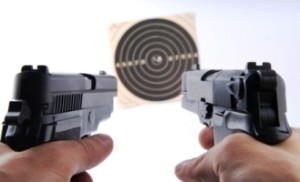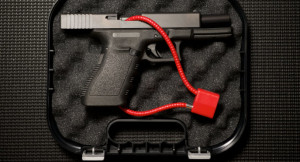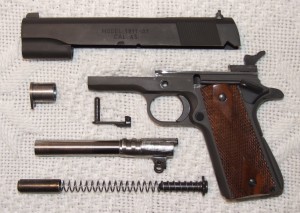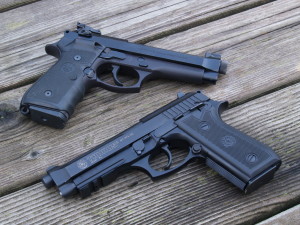Sig Sauer P226 vs Glock 17 Handgun Review
13-Point Gun Comparison
The SIG P226 is an all-metal 15+1 round capacity, hammer fired, DA/SA, 9mm handgun with double stacked magazines. The Gen 3 Glock is a polymer frame locked-breech, double stacked, 17+1 round capacity 9mm with no external hammer. Both have no manual safeties and are superb weapons, both come from companies that are extremely popular with law enforcement and militaries worldwide, and both are suitable weapons for self-defense, home-defense, competition shooting and open carry or over-the-waistband concealed carry. This is our Sig Sauer P226 vs Glock 17 handgun review.
 When comparing two popular 9mm weapons like the Gen 3 Glock 17 and Sig Sauer P226, it truly is like comparing apples and apples. They each have their own strengths and weaknesses and each have a rabid fan base. As I often state, with most well-made similar guns, there are rarely any that everyone 100% agrees are considered better than the other. Finding the right gun for you depends on your own unique physical build, needs, uses, tastes and preferences.
When comparing two popular 9mm weapons like the Gen 3 Glock 17 and Sig Sauer P226, it truly is like comparing apples and apples. They each have their own strengths and weaknesses and each have a rabid fan base. As I often state, with most well-made similar guns, there are rarely any that everyone 100% agrees are considered better than the other. Finding the right gun for you depends on your own unique physical build, needs, uses, tastes and preferences.
So this article will examine thirteen points of comparison and utilizing my experience of owning and shooting both the pistols for over a decade now, I’ll try my best to give you my fair and balanced opinion of which gun is strong in which category, since I’ll already reveal that I personally think they are both equally great guns. After all, I do own and use both of them! I’ll admit that when people ask which one is better, it is almost as if I’m being asked to choose my favorite between two beloved sons. Still, this might help you understand some of these gun’s differences:
13-Point Gun Comparison
1) Appearance: SIG
Yes, there are those that this category is important to. Sure, there are those who might think that the lean, utilitarian and generally considered ugly Glock is beautiful in its own stark way, but myself and most people I’ve ever spoken to, or read about their opinions agree that the more classical 1911 inspired look of the P226 is much more aesthetically pleasing. That and there are still those who consider lightweight polymer guns to be “plastic toys.” Polymer guns are certainly not plastic, and their durability, especially of Glocks really cannot be argued, but if you’re used to the weight and feel of an all-metal gun, the Glock can really seem like a child’s plaything.
2) Accuracy: SIG.
 This isn’t exactly a fair comparison point, not because one gun is better than the other, but this is very subjective and depends on the shooter. Assuming evenly matched and competent shooters, I think the P226 is marginally more accurate with its slightly longer barrel and larger sight radius. The Glock 17 is also considered very accurate, but I think the P226 wins this one by a narrow margin since at greater distances than 15 yards they often seem to have a slight upper hand due to their construction and superior sights. People seem to prefer the P226 for competition shooting, and I think that’s a pretty good indicator that the SIG has a leg up, even if it’s just a slight one.
This isn’t exactly a fair comparison point, not because one gun is better than the other, but this is very subjective and depends on the shooter. Assuming evenly matched and competent shooters, I think the P226 is marginally more accurate with its slightly longer barrel and larger sight radius. The Glock 17 is also considered very accurate, but I think the P226 wins this one by a narrow margin since at greater distances than 15 yards they often seem to have a slight upper hand due to their construction and superior sights. People seem to prefer the P226 for competition shooting, and I think that’s a pretty good indicator that the SIG has a leg up, even if it’s just a slight one.
3) Weight: Glock
All-metal vs. Polymer: no contest. Glock wins hands down. And that does make a difference when it comes to daily carry. The polymer frame Glock with two extra bullets has a loaded weight of 910 grams while the all-metal P226 with only 15 bullets in the magazine weighs in at 965 grams.
4) Safeties: SIG
Neither the Glock nor SIG have external manual safeties. The Glock 17 trigger is part of the Glock Safe Action Pistol safety system. Depressing the center part of the trigger releases the safety and allows the pistol to be fired. This is meant to reduce the risk of accidental firing.
Second, the Glock has an internal firing pin safety. This pin will keep the striker from launching itself forward. Third, there is a drop safety. The gun may be dropped from a significant height, with a round in the chamber, and this safety will make sure that the gun does not discharge.
The P-series double action SIGs are all “point and shoot” guns, whose designs do not require manual safeties. There are three levers or controls on the P226: the slide stop, the magazine release and the decocker. The Glock 17 has two (minus the decocker). The less levers you need to worry about, the quicker you can react without fumbling.
The P226 has the Four-Point safety system which employs a decocking lever, a patented automatic firing pin safety block, a safety intercept notch, and a trigger bar disconnector.
The first point of the safety measure allows the gun to be carried safely with a round in the chamber and the hammer decocked. This converts the relatively light single action trigger to heavier double action that’s much less likely to be accidentally fired. This is important to me especially, since I like to have my gun ready for immediate use in my sometimes problematic neighborhood. I always have a round chambered.
The lack of a manual safety on both the Glock and P226 mean they can be quickly drawn and employed if deadly force is required. The shooter never has to worry about flipping the safety on or off, just draw, point and you’re ready to fire.
 With the second safety point, the intercept notch, the hammer, when decocked, sits just behind the firing pin, not touching it, so you don’t need to worry about spring tension that might somehow accidentally snap forward. Absurd or not, people worry about it. I’ve been on the range with plenty of newbies who were nervous about this very issue. The spring here though isn’t under tension, and the hammer has no way of impacting the firing pin unless the trigger is pulled. When the hammer moves to strike the firing pin when the trigger is pulled, the hammer actually slingshots forward across the gap between the resting position and the firing pin, strikes the pin and then snapping backwards again.
With the second safety point, the intercept notch, the hammer, when decocked, sits just behind the firing pin, not touching it, so you don’t need to worry about spring tension that might somehow accidentally snap forward. Absurd or not, people worry about it. I’ve been on the range with plenty of newbies who were nervous about this very issue. The spring here though isn’t under tension, and the hammer has no way of impacting the firing pin unless the trigger is pulled. When the hammer moves to strike the firing pin when the trigger is pulled, the hammer actually slingshots forward across the gap between the resting position and the firing pin, strikes the pin and then snapping backwards again.
The third point, the firing pin block, is actually built into the slide itself. The firing pin is held back and away from the cartridge primer by a spring, and locked in place using a locking bar built into the slide. When the trigger is pulled, a small lever rises up out of the frame to disengage the locking bar and allow the firing pin to move forwards. Without this safety disengaged, the firing pin wouldn’t move even if struck by the hammer. This helps in the event that the pistol is jarred or dropped.
Finally, the trigger bar disconnect, ensures that while the slide is cycling, the trigger bar is disconnected from the sear to avoid an out-of-battery (before the action has returned to the normal firing position) discharge.
SIG tops off these excellent various safety measures by fashioning a hood on the back of the gun that protects the firing pin from anything coming in from the sides, unlikely or not, and snagging, so most of the complaints I usually have against hammer fired DA/SA pistols have been answered here. Both guns are very safe. Again, it’s hard to say which one will accidentally fire more than the other. I’ve never had any problems. I’ll only say the SIG here is a tad better merely because of the amount of safety precautions put in place which can give new shooters a better sense of security, though to veteran shooters I really don’t think one is considered safer than the other.
5) Grip & Slide Racking: SIG.
 The grips are both comfortable, but the SIG’s more traditional straight grip is what most new shooters are used to. The E2 grips on my SIG are actually some of the most comfortable I’ve ever felt. The texture gives a very sure grip. The Glock grip is very plain but also very comfortable. The weapon is well-suited for a two-handed grip, and fills my large hands very nicely. There isn’t really a lot to say about it; it’s simple and effective. One downside is the grip you buy is the grip you’re stuck with — no options to change them (unlike the Gen 4 interchangeable backstraps). The Glock design must be gotten used to though. The grip angle is weird for many people, and while combat accurate, the Glock is probably not as intrinsically accurate as the SIG without serious practice, because of the grip angle, people tend to shoot high. The slides I find are equally easy to rack. Both have slide grooves that give enough traction. The SIG wins out here mostly because the Glock’s grip angle takes some getting used to and plenty of practice to overcome.
The grips are both comfortable, but the SIG’s more traditional straight grip is what most new shooters are used to. The E2 grips on my SIG are actually some of the most comfortable I’ve ever felt. The texture gives a very sure grip. The Glock grip is very plain but also very comfortable. The weapon is well-suited for a two-handed grip, and fills my large hands very nicely. There isn’t really a lot to say about it; it’s simple and effective. One downside is the grip you buy is the grip you’re stuck with — no options to change them (unlike the Gen 4 interchangeable backstraps). The Glock design must be gotten used to though. The grip angle is weird for many people, and while combat accurate, the Glock is probably not as intrinsically accurate as the SIG without serious practice, because of the grip angle, people tend to shoot high. The slides I find are equally easy to rack. Both have slide grooves that give enough traction. The SIG wins out here mostly because the Glock’s grip angle takes some getting used to and plenty of practice to overcome.
6) Trigger: Glock
The constant 5.5 pound trigger-pull on the Glock works well for me. No hard double action first shot. The trigger reset is also shorter on the Glock.
The initial double action trigger-pull of the SIG at 10 pounds takes some getting used to. Fortunately it’s a smooth, if somewhat long, trigger-pull, and the single action 4.5 pound trigger-pull after the first shot is really smooth and easy to handle. The extra SIG weight really helps against the recoil and makes follow-up shots easier, but this also points to one of the P226’s big drawbacks for me, that first shot often gets away, unless you put serious time into learning proper technique (which of course you should).
7) Price: Glock
The P226 can be nearly double the price of the Glock, and the magazines are a bit more expensive. Though to get the most out of the Glock, you might need to spend a bit on buying better sights, for example, till you get it to the standard you want, so just keep that in mind.
8) Parts and customization: Glock
The availability of OEM replacement parts and upgrades for the Glocks is mind boggling – anything seems possible. On the other hand, though the SIG requires less customization, it is still more difficult to find parts. There is less of a supply out there – as there are fewer SIGs than Glocks out there as well.
9) Overall feel & ergonomics: SIG
Both guns feel nice in my large hands, though there is something to be said about the solid metal feel of the SIG. On the SIG, the slide release sometimes can be bumped during recoil, but this is rarely an issue. You just consciously have to avoid the high thumbs-forward grip, which takes a bit getting used to and is a bit annoying, but after practice this becomes second nature and you don’t think of it too much unless you’re quickly switching between weapons. This would almost be enough to give the Glock the win, but the fact is, despite my great love for the Glock, basing simply on how it feels in my hand, an all-metal 1911 inspired frame will always feel slightly better.
10) Disassembly / Cleaning: Glock
 The SIG is not a difficult gun to disassemble and clean, but the Glocks are all just so easy to quickly disassemble down to the smallest parts for a good cleaning. The Glock’s simplicity of design makes for less hassle and provides fewer parts that can potentially malfunction. The P226, with more parts, takes me significantly longer and the fiddling around with small pins upon reassembly is just not optimal for my big fingers. When you’re pressed for time at the end of a shooting session, this advantage really comes into play.
The SIG is not a difficult gun to disassemble and clean, but the Glocks are all just so easy to quickly disassemble down to the smallest parts for a good cleaning. The Glock’s simplicity of design makes for less hassle and provides fewer parts that can potentially malfunction. The P226, with more parts, takes me significantly longer and the fiddling around with small pins upon reassembly is just not optimal for my big fingers. When you’re pressed for time at the end of a shooting session, this advantage really comes into play.
11) Durability: TIE.
The Glocks are known for their simple rugged durability. With fewer parts to break, you might think this was a shoe in for the Glock, but the fact is that the P226 is just as equally well-made and durable. Yes, it has more parts that can cause issues, but the craftsmanship of these guns (another reason for the higher price-tag) is a real equalizer.
12) Magazines: Glock
One of the advantages of many double stacked 9mm’s is having a large capacity magazine. The Glock takes an advantage with a stock 17 round magazine, whereas the SIG comes with a smaller 15 round magazine. Those two rounds might just be the make or break in any real-life situation. Also, SIG mags are more expensive and aren’t always available everywhere (due to SIGs being less common). Glock mags, however, are incredibly common and factory magazines are very affordable. Though the metal magazine of the SIG does slide out smoother, it still isn’t enough to give it an edge in this category.
13) Recoil: TIE.
The Glock’s bore axis, or how high up from your hand the barrel sits, is lower than the SIG, this helps in recoil control. The SIG, on the other hand, has more weight, which also helps with recoil. This is one of the tougher categories to pick a winner since I have trained with both weapons for such a long time, they both feel equally well controlled and mild in my hands. Some people I know think the SIG has a slightly stronger recoil, while others think the lighter Glock does. I’ll leave it up to you to decide and I’ll just call it a tie!
Final Thoughts
 The SIG is an excellent pistol. The high bore axis, double action trigger pull, and decocking and slide release levers that can sometimes be confusing to a new shooter are all things that can be overcome with practice. The Glock’s real promise is its simplicity of operation and rugged design, which has undergone some of the industry’s most rigorous durability testing, and come through with flying colors. I shoot both roughly the same amount at the range and while I generally carry my Glock and keep my P226 for the home-defense role, both have equal room in my heart. Make sure you test these and other guns before choosing which you think is best suited to you. Make sure it fills your specific needs, uses, tastes and grip. If you found one that fulfills that, you’re set. Just make sure that whatever you get, you train on enough to become properly proficient in it. You want to get to a level where you’re not only consistently hitting the targets with tight groupings, but the handling of the gun is so instinctive to you, that you can fire it even under stressful real-life situations and hit what you’re aiming at. I hope this has helped you. Best of luck in finding the right gun for you!
The SIG is an excellent pistol. The high bore axis, double action trigger pull, and decocking and slide release levers that can sometimes be confusing to a new shooter are all things that can be overcome with practice. The Glock’s real promise is its simplicity of operation and rugged design, which has undergone some of the industry’s most rigorous durability testing, and come through with flying colors. I shoot both roughly the same amount at the range and while I generally carry my Glock and keep my P226 for the home-defense role, both have equal room in my heart. Make sure you test these and other guns before choosing which you think is best suited to you. Make sure it fills your specific needs, uses, tastes and grip. If you found one that fulfills that, you’re set. Just make sure that whatever you get, you train on enough to become properly proficient in it. You want to get to a level where you’re not only consistently hitting the targets with tight groupings, but the handling of the gun is so instinctive to you, that you can fire it even under stressful real-life situations and hit what you’re aiming at. I hope this has helped you. Best of luck in finding the right gun for you!
https://www.youtube.com/watch?v=i_Ttu66-OhQ
No comments yet.